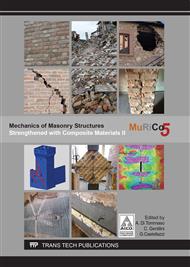[1]
Carloni C., Focacci F., FRP-Masonry Interfacial Debonding: An Energy Balance Approach to Determine the Influence of the Mortar Joints. European Journal of Mechanics A/Solids, 55, (2016), 122–133.
DOI: 10.1016/j.euromechsol.2015.08.003
Google Scholar
[2]
Focacci F., Carloni C., Periodic variation of the transferable load at the FRP-masonry interface. Composite Structures, 129, (2015), 90-100.
DOI: 10.1016/j.compstruct.2015.03.008
Google Scholar
[3]
Carloni C., Subramaniam K.V., FRP-Masonry Debonding: Numerical and Experimental Study of the Role of Mortar Joints. ASCE Journal of Composites for Construction, 16(5), (2012), 581-589.
DOI: 10.1061/(asce)cc.1943-5614.0000282
Google Scholar
[4]
A. D'Ambrisi, F. Focacci. Flexural strengthening of RC beams with cement-based composites, J Comp Constr 15: 5 (2011) 707-720.
DOI: 10.1061/(asce)cc.1943-5614.0000218
Google Scholar
[5]
Loreto, L. Leardini, D. Arboleda, A. Nanni. Performance of RC slab-type elements strengthened with fabric reinforced cementitious matrix composites. J Compos Constr 18: 3 (2013) 1–9.
DOI: 10.1061/(asce)cc.1943-5614.0000415
Google Scholar
[6]
C. Pellegrino, T. D'Antino. Experimental behavior of existing precast prestressed reinforced concrete elements strengthened with cementitious composites. Compos - Part B: Eng. 55 (2013)31-40.
DOI: 10.1016/j.compositesb.2013.05.053
Google Scholar
[7]
L.H. Sneed, S. Verre, C. Carloni, C., L. Ombres. Flexural behavior of RC beams strengthened with steel-FRCM composite. Eng Struct 127 (2016) 686-699.
DOI: 10.1016/j.engstruct.2016.09.006
Google Scholar
[8]
M.Y. Alabdulhadya, L.H. Sneed, C. Carloni. Torsional behavior of RC beams strengthened with PBO-FRCM composite – an experimental study. Eng Struc 136 (2017) 393–405.
DOI: 10.1016/j.engstruct.2017.01.044
Google Scholar
[9]
A. D'Ambrisi, L. Feo, F. Focacci, Experimental analysis on bond between PBO-FRCM strengthening materials and concrete, Compos - Part B: Eng. 44: 1 (2013) 524–32.
DOI: 10.1016/j.compositesb.2012.03.011
Google Scholar
[10]
T. D'Antino, C. Carloni, L.H. Sneed, C. Pellegrino. Matrix-fiber bond behavior in PBO FRCM composites – a fracture mechanics approach. Eng Frac Mech J 117 (2014) 94-111.
DOI: 10.1016/j.engfracmech.2014.01.011
Google Scholar
[11]
L.H. Sneed, T. D'Antino, C. Carloni. Investigation of bond behavior of PBO fiber-reinforced cementitious matrix-composite concrete interface. ACI Mat J 111: 5 (2014) 569-580.
DOI: 10.14359/51686604
Google Scholar
[12]
C. Carloni, T. D'Antino, L.H. Sneed, C. Pellegrino. Role of the matrix layers in the stress-transfer mechanism of FRCM composites bonded to a concrete substrate. ASCE J of Eng Mech 141: 6 (2015).
DOI: 10.1061/(asce)em.1943-7889.0000883
Google Scholar
[13]
L.H. Sneed, T. D'Antino, C. Carloni, C. Pellegrino. A comparison of the bond behavior of PBO-FRCM composites determined by single-lap and double-lap shear tests. Cem and Conc Compos 64 (2015) 37-48.
DOI: 10.1016/j.cemconcomp.2015.07.007
Google Scholar
[14]
C. Carloni, S. Verre, L.H. Sneed, L. Ombres. Loading rate effect on the debonding phenomenon in fiber reinforced cementitious matrix-concrete joints. Compos - Part B: Eng 108 (2017) 301–314.
DOI: 10.1016/j.compositesb.2016.09.087
Google Scholar
[15]
G. De Felice, S. De Santis, L. Garmendia, B. Ghiassi, P. Larrinaga, P.B. Lourenco, D.V. Oliveira, F. Paolacci, C.G. Papanicolaou. Mortar-based systems for externally bonded strengthening of masonry. Mater Struct 47 (2014) 2021-(2037).
DOI: 10.1617/s11527-014-0360-1
Google Scholar
[16]
G. Carozzi, C. Poggi, Mechanical properties and debonding strength of fabric reinforced cementitious matrix (FRCM) systems for masonry strengthening, Compos - Part B: Eng. 70 (2015) 215-230.
DOI: 10.1016/j.compositesb.2014.10.056
Google Scholar
[17]
M.R. Valluzzi, F. Daporto, E. Garbin, M. Panizza. Out-of-plane behavior of infill masonry panels strengthened with composite materials. Mater Struct 47 (2014) 2131-2145.
DOI: 10.1617/s11527-014-0384-6
Google Scholar
[18]
S. Babaeidarabad, F. De Caso, A. Nanni. URM walls strengthened with fabric-reinforced cementitious matrix composite subjected to diagonal compression. J Compos Constr 18: 2 (2013).
DOI: 10.1061/(asce)cc.1943-5614.0000441
Google Scholar
[19]
V. Alecci, F. Focacci, L. Rovero, G. Stipo, M. De Stefano. Extrados strengthening of brick masonry arches with PBO-FRCM composites: experimental and analytical investigations. Compos Struct 149: 1 (2016) 184-196.
DOI: 10.1016/j.compstruct.2016.04.030
Google Scholar
[20]
V. Giamundo, G.P. Lignola, G. Maddaloni, A. Balsamo, A. Prota, G. Manfredi. Experimental investigation of the seismic performances of IMG reinforcement on curved masonry elements. Compos - Part B: Eng 70 (2015) 53-63.
DOI: 10.1016/j.compositesb.2014.10.039
Google Scholar
[21]
A. Bellini, A. Incerti, C. Mazzotti, Out-of-plane behavior of masonry walls strengthened by FRCM composites, 10th Int. Conf. on Structural Analysis of Historical Constructions, SAHC 2016; Leuven; Belgium; 13 September (2016).
DOI: 10.1201/9781315616995-142
Google Scholar
[22]
CEN, EN 772-1, 2011. Methods of test for masonry units – Part 1: Determination of compressive strength. A1: 2015. Brussels: CEN.
Google Scholar
[23]
Henzel J., Karl S., 1987, Determination of strength of mortar in the joints of masonry by compression tests on small specimens, «Darmstadt Concrete», 2, 123-136.
Google Scholar
[24]
Kerakoll S. p.A. – web site: <www. kerakoll. com> [accessed Feb 2017].
Google Scholar
[25]
CEN, EN 1015-11: 1999. Methods of test for mortar for masonry – Part 11: Determination of flexural and compressive strength of hardened mortar. A1: 2006. Brussels: CEN.
DOI: 10.3403/01905442
Google Scholar


